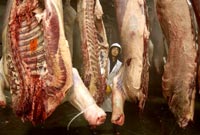British investigation indicates lab site likely source of foot-and-mouth outbreak
Health and safety experts worked Wednesday to determine whether an outbreak of foot-and-mouth disease in southern England came from a high-security government laboratory or from a private pharmaceutical company on the same site - and whether its spread was accidental or deliberate.

The country's health and safety agency said in a report late Tuesday that there was a "strong probability" the outbreak originated at a nearby laboratory site and was spread by human movement.
The virus was discovered last week on a farm four miles (6Ѕ kilometers) from the Pirbright lab complex, which is shared by the government's Institute for Animal Health and a company that produces foot-and-mouth vaccines, Merial Animal Health - the British arm of Duluth, Georgia-based Merial Ltd.
The government's Health and Safety Executive said there was a "real possibility" the disease was spread by human movement, while the possibility it was transmitted by wind or floodwaters was negligible.
It said there were various potential routes for "accidental or deliberate transfer of material from the site."
Foot-and-mouth can be carried by wind and on the vehicles and clothes of people who come into contact with infected animals.
The Daily Mail newspaper reported Wednesday that one theory being investigated was that a lab worker had carried the virus on boots or clothing to a vegetable patch near the first infected farm.
Environment Secretary Hilary Benn said it was unclear whether the outbreak was the result of accidental or deliberate human contamination.
"The truth is, we don't know," he said. "We're all very, very anxious."
Benn said the report had brought efforts to stop the disease "a bit further forward" and that the possibility the strain had been released by human movement would be urgently investigated.
National Farmers' Union President Peter Kendall said the findings would only "add to the frustration and anger" of farmers.
"I have spoken to many farmers over the last few days who are absolutely horrified that the source of this outbreak could be from Pirbright - and the suggestion in the findings that the disease could have been transferred, either accidentally or deliberately, by humans will only add to these concerns."
A group of cows at a second farm was confirmed to have the disease Tuesday. Cranes piled cattle carcasses onto trucks and authorities slightly expanded the protection zone around a second farm, scrambling to halt the spread of the highly contagious virus to other herds in southern England.
Both farms, about 30 miles (50 kilometers) southwest of London, were within a two-mile (three-kilometer) radius protection zone set up Friday, Benn said.
News of the second confirmed outbreak fed fears of a repeat of scenes in 2001, when 7 million animals were culled and incinerated on pyres and Britain's agriculture and rural tourism industries were devastated.
Prime Minister Gordon Brown said a second report on the origins of the outbreak was expected as early as Wednesday.
"The work goes on to isolate, to contain, control and eradicate the disease," Brown said.
The health and safety agency said the Institute for Animal Health could resume normal operations, "providing that all the usual biosecurity protocols are followed rigorously."
But it said Merial should not immediately resume production, despite a pending government order for 300,000 doses of a strain-specific foot-and-mouth vaccine.
The disease strain was used in both labs. Merial produced about 10,000 liters of vaccine between July 14 and 25 while the institute conducted a series of small-scale experiments - using fewer than 10 milliliters in each case, the report said.
Merial said "intensive internal investigations" had found no evidence of biosecurity breaches.
"To date, we have not been able to establish any evidence that the virus may have been transported out of our center by humans," the company said in a statement.
"We fully support the investigation and will continue to cooperate and provide complete access to our center to enable these investigations to continue."
Foot-and-mouth disease affects cloven-hoofed animals, including cows, sheep, pigs and goats, but does not typically affect humans.
Subscribe to Pravda.Ru Telegram channel, Facebook, RSS!


